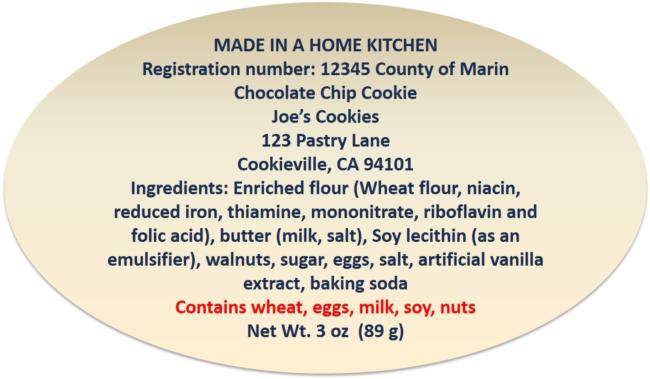Label Requirements
Cottage food products are required to be labeled in accordance with specific state and federal labeling regulations. The following requirements are intended to assist CFOs in complying with basic labeling laws and regulations. Labels on packaged, processed foods usually have two distinct areas: the principal display panel and the information panel. The principal display panel information lists the product name and net quantity of contents, and is most often the label the consumer will see first as it is generally located on the front of the package. The information panel is usually located to the immediate right of the principal display panel and contains the nutrition facts statement.
By using computer generated labels, cottage food operators may forego the information panel, and list all required information on the principal display panel, provided that the information is displayed in a size and manner that will allow the information to be read by the average consumer.
Labels on cottage food products must contain the following information:
(1) The common or descriptive name of the cottage food product located on the principal display panel.
(2) The name, city, and zip code of the CFO. Note: If the CFO is not listed in a current telephone directory, then a physical address must also be included on the label.
(3) The words “Made (or Repackaged) in a Home Kitchen” must appear on the principal display panel in 12-point type.
(4) The registration or permit number of the “Class A” or “Class B” CFO and the name of the local enforcement agency that issued the permit number.
(5) If the cottage food product contains two or more ingredients, list the ingredients of the product, in descending order by predominance of weight.
(6) The net quantity (count, weight, or volume) of the food product, stated in both English (pound) units and metric units (grams).
(7) If the food product contains any of the major food allergens (milk, eggs, fish, shellfish, tree nuts, wheat, peanuts, and soybeans), it must be stated on the label in plain language. There are two approved methods prescribed by federal law for declaring the food sources of allergens in packaged foods: 1) Have a separate summary statement immediately following or adjacent to the ingredient list; or 2) Have the allergen listed within the ingredient list.
Anaphylactic shock can occur in certain sulfite-sensitive individuals upon ingesting 10 milligrams or more of sulfites. If such an amount of sulfites are added (most commonly for dried fruits), they must be declared with the statement: Contains added sulfites.
Below is an example of a principal display panel of a cottage food label.

(8) Nutrient content claims involve the use of any of the following eleven terms: free, low, reduced, fewer, high, less, more, lean, extra lean, good source, and light. If such claims are made, they must comply with the Food and Drug Administration’s conditions for the use of these terms. (For details, refer to 21 CFR Sections 101.13 and 101.54 et seq.) For example: the term “sodium free” means that the food contains less than 5 milligrams of sodium per serving.
(9) A health claim is a statement or message on the label that describes the relationship between a food component and a disease or health-related condition (e.g., sodium and hypertension, calcium and osteoporosis). If a health claim is made, it must conform to the federal requirements established in 21 CFR 101.14 and 101.70 et seq.
(10) Nutrition Facts panels generally are not required for CFOs. If the food label makes any nutrient content or health claims, then nutrition information must be declared in a “Nutrition Facts” statement, as specified by the Food and Drug Administration: Nutrition Facts Label Programs & Materials.
(11) Labels must be legible and in English; accurately translated information in another language is optional.
Resources
Labeling Requirements for Cottage Food Products (CDPH, PDF 488 KB)
